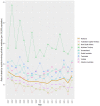Road vehicle collision suicide in Australia: Trends, collision types, and individual characteristics
- PMID: 38687768
- PMCID: PMC11060530
- DOI: 10.1371/journal.pone.0299590
Road vehicle collision suicide in Australia: Trends, collision types, and individual characteristics
Abstract
Background: Suicide by road vehicle collision in Australia is under-explored with mixed findings. We aimed to address this research gap by examining time trends, different types of vehicle collision, and individual characteristics related to vehicle-collision suicide.
Method: We retrospectively analyzed deaths by suicide between 1st January 2001 and 31st December 2017 in Australia, using coronial records from the National Coronial Information System. The travel mode used and collision counterpart were retrieved from records of death by vehicle-collision suicide using all available information. We conducted negative binomial regression analysis to examine annual changes in suicide rate by vehicle collision on a public road (N = 640) and other methods of suicide (N = 41,890), and logistic regression analysis to examine individual characteristics associated with the likelihood of dying by suicide via road vehicle collision.
Results: Overall, the national suicide rate involving road vehicle collision significantly increased, while the rate by other methods significantly decreased. Drivers accounted for 61% of suicide events by vehicle collision, of which 72% were single-vehicle collisions (commonly involving a tree). For multiple-vehicle collision suicide events, 82% involved collision with a truck. Pedestrians accounted for more than one-third of suicide events, of which 58% involved collision with a truck and 23% involved collision with a car/van. Individuals who were male (odds ratio 1.15; 95% CI 0.88-1.50), aged <25 years old (odds ratio 5.27; 95% CI 3.05-9.10), non-Indigenous (odds ratio 3.36; 95% CI 1.71-6.62), and born overseas (odds ratio 1.40; 95% CI 1.10-1.79) were more likely to die by vehicle-collision suicide than by other methods of suicide.
Conclusions: This study provides a better understanding of road vehicle collision suicide in Australia and informs future research directions on topic. Our findings can be used to inform suicide prevention initiatives to reduce vehicle-collision suicide deaths.
Copyright: © 2024 Law et al. This is an open access article distributed under the terms of the Creative Commons Attribution License, which permits unrestricted use, distribution, and reproduction in any medium, provided the original author and source are credited.
Conflict of interest statement
The authors have declared that no competing interests exist.
Figures
Similar articles
-
Road traffic collisions in Malawi: Trends and patterns of mortality on scene.Malawi Med J. 2017 Dec;29(4):301-305. doi: 10.4314/mmj.v29i4.4. Malawi Med J. 2017. PMID: 29963284 Free PMC article.
-
Multilevel models for evaluating the risk of pedestrian-motor vehicle collisions at intersections and mid-blocks.Accid Anal Prev. 2015 Nov;84:99-111. doi: 10.1016/j.aap.2015.08.013. Epub 2015 Sep 1. Accid Anal Prev. 2015. PMID: 26339944 Free PMC article.
-
Identifying motorist characteristics associated with youth bicycle-motor vehicle collisions.Traffic Inj Prev. 2019;20(7):744-748. doi: 10.1080/15389588.2019.1639680. Epub 2019 Aug 13. Traffic Inj Prev. 2019. PMID: 31407928
-
Road accident fatality risks for "vulnerable" versus "protected" road users in northern Ghana.Traffic Inj Prev. 2017 Oct 3;18(7):736-743. doi: 10.1080/15389588.2017.1302083. Epub 2017 Mar 15. Traffic Inj Prev. 2017. PMID: 28296466 Review.
-
Child road traffic injury mortality in Victoria, Australia (0-14 years), the need for targeted action.Injury. 2018 Mar;49(3):604-612. doi: 10.1016/j.injury.2017.12.018. Epub 2017 Dec 21. Injury. 2018. PMID: 29361292 Review.
References
-
- Radun I, Radun J, Kaistinen J, Parkkari I, Kecklund G, Olivier J, et al.. Suicide by crashing into a heavy vehicle: A one-year follow-up study of professional drivers. Transp Res Part F Traffic Psychol Behav. 2020;73:318–24.
Publication types
MeSH terms
LinkOut - more resources
Full Text Sources
Medical
Miscellaneous



